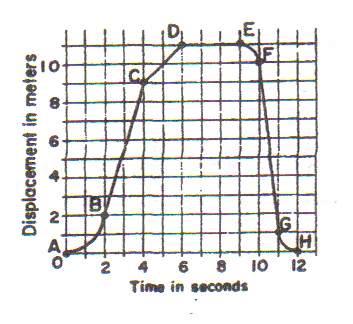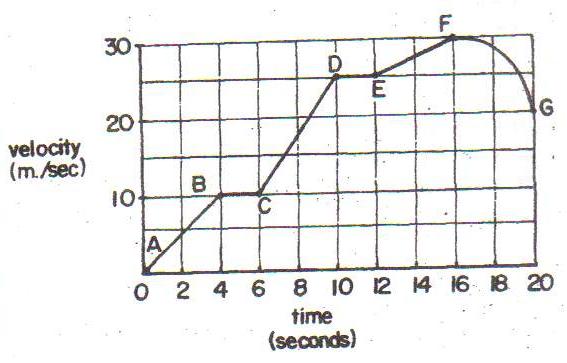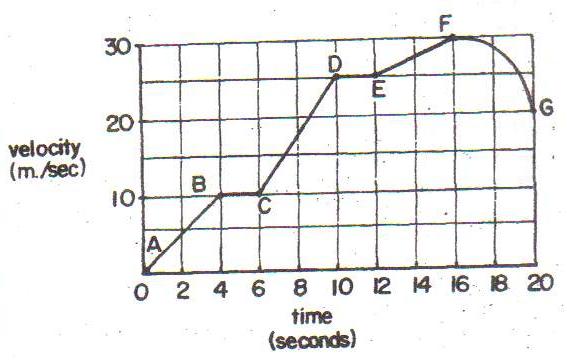AP Physics Test 1a

This is Mr. Gromatsky's physics test 1A. These are regents style questions.
- 1.
An object originally at rest is uniformly accelerated along a straight-line path to a speed of 8.0 meters per second in 2.0 seconds. What was the acceleration of the object?
- A.
0.25 m/s^2
- B.
10 m/s^2
- C.
16 m/s^2
- D.
4 m/s^2
Correct Answer
D. 4 m/s^2Explanation
The acceleration of an object can be calculated using the equation: acceleration = (final velocity - initial velocity) / time. In this case, the initial velocity is 0 m/s (since the object was originally at rest), the final velocity is 8.0 m/s, and the time is 2.0 seconds. Plugging these values into the equation, we get: acceleration = (8.0 m/s - 0 m/s) / 2.0 s = 4 m/s^2. Therefore, the acceleration of the object is 4 m/s^2.Rate this question:
-
- 2.
A 30-kilogram boy exerts a force of 100 Newtons on a 50-kilogram object. The force that the object exerts on the boy is
- A.
0 N
- B.
100 N
- C.
980 N
- D.
1,500 N
Correct Answer
B. 100 NExplanation
According to Newton's third law of motion, for every action, there is an equal and opposite reaction. In this case, the boy exerts a force of 100 Newtons on the object. As a result, the object exerts an equal and opposite force of 100 Newtons on the boy. Therefore, the force that the object exerts on the boy is 100 N.Rate this question:
-
- 3.
If the sum of all the forces acting on a car is zero, then the speed of the car always
- A.
Decreases
- B.
Increases
- C.
Remains the same
Correct Answer
C. Remains the sameExplanation
If the sum of all the forces acting on a car is zero, it means that the forces pushing the car forward and the forces resisting its motion are balanced. In this case, the car experiences no net force, which means there is no acceleration or deceleration. Therefore, the speed of the car remains constant.Rate this question:
-
- 4.
As a constant unbalanced force acts on an object in the direction of motion, the object's speed
- A.
Decreases
- B.
Increases
- C.
Remains the same
Correct Answer
B. IncreasesExplanation
When a constant unbalanced force acts on an object in the direction of motion, the object's speed increases. This is because the force is causing an acceleration, which in turn causes the object to gain speed. The object will continue to increase its speed as long as the force is applied.Rate this question:
-
- 5.
An object is uniformly accelerated from rest to a speed of 24 meters per second in 10 seconds. The acceleration of the object is
- A.
1.0 m/s^2
- B.
2.0 m/s^2
- C.
1.5 m/s^2
- D.
2.5 m/s^2
Correct Answer
D. 2.5 m/s^2Explanation
The acceleration of an object can be calculated using the equation: acceleration = (final velocity - initial velocity) / time. In this case, the object starts from rest (initial velocity = 0 m/s) and reaches a final velocity of 24 m/s in 10 seconds. Plugging these values into the equation, we get acceleration = (24 m/s - 0 m/s) / 10 s = 2.4 m/s^2. Therefore, the correct answer is 2.5 m/s^2.Rate this question:
-
- 6.
If the mass of an object were doubled, its weight would be
- A.
Halved
- B.
Doubled
- C.
Quadrupled
- D.
Unchanged
Correct Answer
B. DoubledExplanation
When the mass of an object is doubled, its weight would also double. This is because weight is directly proportional to mass. The weight of an object is determined by the force of gravity acting on it, and this force is directly proportional to the mass of the object. Therefore, if the mass is doubled, the force of gravity acting on it will also double, resulting in the weight being doubled.Rate this question:
-
- 7.
A 2-newton force acts on a 3-kilogram mass for 6 seconds. The change of velocity of the mass is
- A.
18 m/s
- B.
2 m/s
- C.
36 m/s
- D.
4 m/s
Correct Answer
D. 4 m/sExplanation
The change of velocity of an object can be calculated using the equation F = ma, where F is the force applied, m is the mass of the object, and a is the acceleration. In this case, the force applied is 2 newtons and the mass of the object is 3 kilograms. Therefore, the acceleration can be calculated as a = F/m = 2/3 = 0.67 m/s^2. Since the object is acted upon by this acceleration for 6 seconds, the change in velocity can be calculated as v = at = 0.67 * 6 = 4 m/s.Rate this question:
-
- 8.
Which is a vector quantity?
- A.
Distance
- B.
Speed
- C.
Displacement
- D.
Time
Correct Answer
C. DisplacementExplanation
Displacement is a vector quantity because it has both magnitude and direction. It represents the change in position of an object from its initial point to its final point, taking into account the direction of the movement. In contrast, distance is a scalar quantity as it only represents the magnitude of the total path traveled, without considering the direction. Speed is also a scalar quantity as it only represents the magnitude of the rate at which an object is moving. Time is a scalar quantity as it only represents the magnitude of the duration of an event.Rate this question:
-
- 9.
The graph represents the trip of a cart along a straight line. The total trip takes 12 seconds and starts at t = 0.The part of the trip during which the cart was at rest is represented by line
- A.
AB
- B.
BC
- C.
DE
- D.
GH
Correct Answer
C. DEExplanation
The correct answer is DE. This is because the line segment DE represents a horizontal line, indicating that the cart is not moving during that time period. This indicates that the cart is at rest during the time represented by DE.Rate this question:
-
- 10.
What was the total distance covered by the cart during the trip (AH)?
- A.
6m
- B.
11m
- C.
12m
- D.
22m
Correct Answer
D. 22mExplanation
The correct answer is 22m because it is the highest distance mentioned in the options. Since the question asks for the total distance covered by the cart during the trip, we can assume that the cart traveled different distances at different points during the trip. Therefore, the total distance covered would be the sum of all the distances mentioned, which is 22m.Rate this question:
-
- 11.
What is the average speed of the cart during the part of the trip labeled CD ?
- A.
1 m/s
- B.
2 m/s
- C.
10 m/s
- D.
11 m/s
Correct Answer
A. 1 m/sExplanation
The average speed of the cart during the part of the trip labeled CD is 1 m/s. This means that, on average, the cart traveled 1 meter per second during that specific part of the trip.Rate this question:
-
- 12.
The part of the trip during which the cart was moving with a constant speed is represented by line
- A.
AB
- B.
BC
- C.
EF
- D.
GH
Correct Answer
B. BCExplanation
The correct answer is BC because it is the only line segment on the graph that shows a horizontal line, indicating that the cart was moving with a constant speed during that part of the trip. The other line segments show either an upward or downward slope, indicating a change in speed.Rate this question:
-
- 13.
The part of the trip during which acceleration was not 0 is represented by the line
- A.
AB
- B.
BC
- C.
DE
- D.
FG
Correct Answer
A. ABExplanation
The line AB represents the part of the trip during which acceleration was not 0. This means that there was a change in velocity during this time period. The other lines BC, DE, and FG do not represent a change in velocity as they are horizontal lines, indicating constant velocity or zero acceleration.Rate this question:
-
- 14.
A man weighing 800 Newtons is standing in an elevator. If the elevator rises with an acceleration of 9.8 meters per second^2, the force exerted by the elevator on the man will be
- A.
400 N
- B.
800 N
- C.
1600 N
- D.
2000 N
Correct Answer
C. 1600 NExplanation
When the elevator rises with an acceleration of 9.8 meters per second^2, the man inside the elevator experiences an upward force due to the acceleration. This force is equal to the product of the man's mass and the acceleration. According to Newton's second law of motion, force equals mass times acceleration. The man's weight is equal to his mass multiplied by the acceleration due to gravity, which is approximately 9.8 meters per second^2. Since the man weighs 800 Newtons, his mass is approximately 81.63 kg. Therefore, the force exerted by the elevator on the man is equal to the product of the man's mass and the elevator's acceleration, which is approximately 81.63 kg * 9.8 m/s^2 = 1597.53 N. Rounded to the nearest whole number, the force exerted by the elevator on the man will be 1600 N.Rate this question:
-
- 15.
The graph below shows the speed of an object plotted against the time.The total distance traveled by the object during the first 4 seconds is
- A.
0.5 meter
- B.
2 meters
- C.
8 meters
- D.
4 meters
Correct Answer
D. 4 metersExplanation
The graph shows a straight line with a constant slope, indicating that the object is moving at a constant speed. The distance traveled by an object can be calculated by multiplying its speed by the time taken. In this case, the object's speed remains constant, so we can simply multiply the speed by the time to find the distance. Since the time given is 4 seconds and the speed is not mentioned, we can assume that the speed remains constant throughout the 4 seconds. Therefore, the distance traveled by the object during the first 4 seconds is 4 meters.Rate this question:
-
- 16.
An object is allowed to fall freely near the surface of a planet. The object has an acceleration due to gravity of 24 m/s^2. How far will the object fall during the first second?
- A.
24 meters
- B.
12 meters
- C.
9.8 meters
- D.
4.9 meters
Correct Answer
B. 12 metersExplanation
The object will fall 12 meters during the first second because the acceleration due to gravity is 24 m/s^2. This means that for every second the object falls, its velocity will increase by 24 m/s. Since the object is falling freely, its initial velocity is 0 m/s. Using the equation d = 1/2 * a * t^2, where d is the distance, a is the acceleration, and t is the time, we can calculate the distance. Plugging in a = 24 m/s^2 and t = 1 second, we get d = 1/2 * 24 * 1^2 = 12 meters.Rate this question:
-
- 17.
When an unbalanced force of 10 Newtons is applied to an object whose mass is 4.0 kilograms, the acceleration of the object will be
- A.
40 m/s^2
- B.
2.5 m/s^2
- C.
9.8 m/s^2
- D.
0.40 m/s^2
Correct Answer
B. 2.5 m/s^2Explanation
The acceleration of an object can be calculated using the formula F = ma, where F is the force applied to the object and m is the mass of the object. In this case, the force applied is 10 Newtons and the mass of the object is 4.0 kilograms. Plugging these values into the formula, we get 10 = 4.0a. Solving for a, we find that the acceleration of the object is 2.5 m/s^2.Rate this question:
-
- 18.
A 1-kilogram object rests on a horizontal table top. The force that the table top exerts on the object is
- A.
1 N
- B.
2 N
- C.
0 N
- D.
9.8 N
Correct Answer
D. 9.8 NExplanation
The force that the table top exerts on the object is 9.8 N. This is because the object is at rest on the table, meaning that the gravitational force pulling it downward is balanced by an equal and opposite normal force exerted by the table. According to Newton's third law of motion, the normal force exerted by the table on the object is equal in magnitude and opposite in direction to the force exerted by the object on the table. Since the weight of the object is 9.8 N (mass of 1 kg multiplied by the acceleration due to gravity, 9.8 m/s^2), the normal force exerted by the table on the object is also 9.8 N.Rate this question:
-
- 19.
No unbalanced force is acting on the car during time interval
- A.
BC
- B.
CD
- C.
EF
- D.
FG
Correct Answer
A. BCExplanation
During the time interval BC, no unbalanced force is acting on the car. This means that the forces acting on the car are balanced, resulting in no net force. As a result, the car will continue to move at a constant velocity or remain at rest if it was initially stationary.Rate this question:
-
- 20.
The acceleration of the car during time interval AB is
- A.
0.40 m/sec^2
- B.
2.5 m/sec^2
- C.
10 m/sec^2
- D.
40 m/sec^2
Correct Answer
B. 2.5 m/sec^2Explanation
The correct answer is 2.5 m/sec^2. This means that the car's acceleration during the time interval AB is 2.5 meters per second squared. Acceleration is the rate at which an object changes its velocity over time. In this case, the car's velocity is increasing at a rate of 2.5 meters per second every second. This indicates that the car is experiencing a significant increase in speed during this time interval.Rate this question:
-
- 21.
During time interval CD, the average velocity of the car is
- A.
7.5 m/sec
- B.
17.5 m/sec
- C.
15 m/sec
- D.
35 m/sec
Correct Answer
B. 17.5 m/secExplanation
During time interval CD, the average velocity of the car is 17.5 m/sec. This means that over the time interval CD, the car traveled an average of 17.5 meters per second. Average velocity is calculated by dividing the total displacement of the car during the time interval by the total time taken. Since the question does not provide any additional information, we can assume that the car maintained a constant velocity throughout the time interval CD.Rate this question:
-
- 22.
A 2.0-kilogram mass is pushed along a horizontal frictionless surface by a 3.0-newton force which is parallel to the surface.The weight of the mass is approximately
- A.
9.8 N
- B.
2.0 N
- C.
20 N
- D.
4 N
Correct Answer
C. 20 NExplanation
The weight of an object is the force exerted on it due to gravity. It is given by the equation weight = mass * acceleration due to gravity. In this case, the mass is given as 2.0 kilograms. The acceleration due to gravity is approximately 9.8 m/s^2. Therefore, the weight of the mass is approximately 2.0 kg * 9.8 m/s^2 = 19.6 N. Since the weight is not exactly 20 N but rather approximately 19.6 N, it can be concluded that the closest option is 20 N.Rate this question:
-
Quiz Review Timeline +
Our quizzes are rigorously reviewed, monitored and continuously updated by our expert board to maintain accuracy, relevance, and timeliness.
-
Current Version
-
Mar 21, 2023Quiz Edited by
ProProfs Editorial Team -
Nov 17, 2009Quiz Created by
Apphysicswebmast










